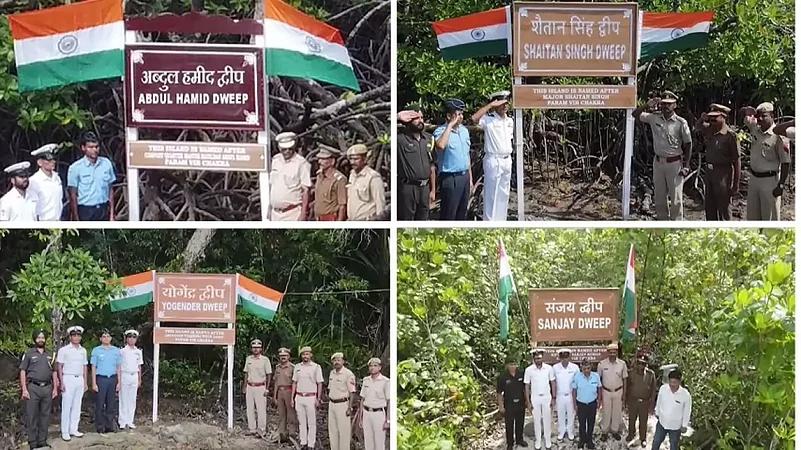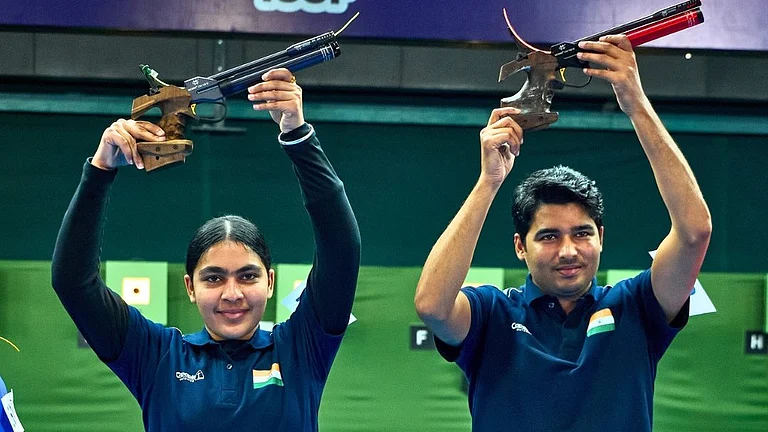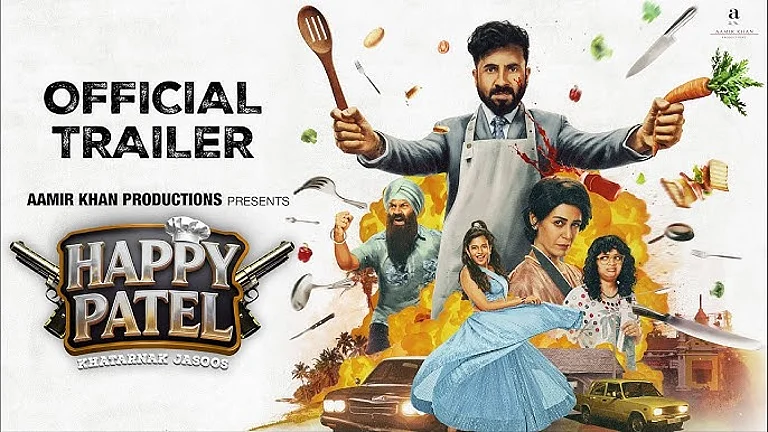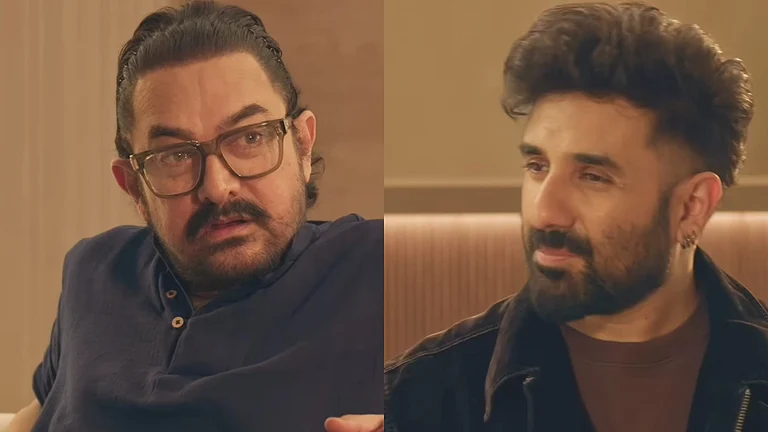Prime Minister Narendra Modi on Monday named 21 islands in the Andaman and Nicobar Islands after recipients of Param Vir Chakra.
The Param Vir Chakra is India's highest gallantry award in war. It was established in 1947 and only 21 armed forces personnel have been honoured with it.
Naming the islands after Param Vir Chakra recipients, Modi said islands named after war heroes will be a source of inspiration for people.
He said, “Islands named today after Param Vir Chakra awardees will be the land of inspiration for generations to come.”
Earlier, Union Home Minister Amit Shah lauded the initiative to name the islands and said this effort will be a source of encouragement for Indian military.
What's Param Vir Chakra?
The Param Vir Chakra is the highest wartime gallantry award in India.
The Param Vir Chakra is granted for "most conspicuous bravery in the presence of the enemy".
The first recipient of the Param Vir Chakra was Major Somnath Sharma for his actions in the 1947-48 India-Pakistan War and the last recipient was Captain Vikram Batra for actions in the Kargil War in 1999.
List of Param Vir Chakra recipients
The Param Vir Chakra has been granted to 21 armed forces personnel for "most conspicuous bravery in the presence of the enemy".
Most of the of Param Vir Chakras were granted posthumously as they made the supreme sacrifice in the line of duty. There are only three living Param Vir Chakra recipients at the moments.
Here is the list of the 21 Param Vir Chakra recipients.
1. Major Somnath Sharma of the Indian Army's 4 Kumaon Regiment was the first recipient of Param Vir Chakra. He was honoured for his actions in Srinagar on November 3, 1947, during the 1947-48 India-Pakistan War when Pakistan had invaded Jammu and Kashmir.
Sharma and soldiers of his company are credited with saving Srinagar and preventing Kashmir Valley from falling into Pakistan's hands.
"The gallant actions of Major Sharma and his men from 4 battalions Kumaon successfully thwarted the attack by the Pakistani raiders and provided the much-needed time for the Indian army to fortify defenses around Srinagar, thus, enabling India to prevent Kashmir from falling into the hands of the enemy," notes the Government of India.
Sharma was granted the Param Vir Chakra posthumously.
2. Naik Jadunath Singh of the Indian Army's 1 Rajput Regiment was granted Param Vir Chakra for actions at Tain Dhar near Naushera in Jammu & Kashmir.
"On 6 February 1948, enemy forces attacked his post in successive waves. He and his section were able to ward off three successive attacks by the enemy. By the end of third wave, of the 27 men at the post, 24 men were killed or severely wounded. Despite being grievously injured, armed with a Sten Gun, he single-handedly charged with such courage as to cause the attackers to withdraw," notes the Government of India.
Singh was granted Param Vir Chakra posthumously.
3. 2nd Lt Rama Raghoba Rane of the Indian Army's Bombay Sappers was granted Param Vir Chakra in Jammu and Kashmir in 1948.
Rane crawled under a moving Indian tank and synchronised movement with the tank and guided it through the minefield.
The Government of India notes, "On 08 April 1948, Second Lieutenant Rama Raghoba Rane of Bombay Sappers, was in charge of the mine and roadblock clearing party at Mile 26 on Naushera-Rajouri road. The enemy started heavy shelling of the area, killing two and injuring five of the mine clearing party.
"Despite being wounded Second Lieutenant Rane crouched under a monstrous Stuart tank and began crawling with it. He synchronized himself with the movements of dangerous tank wheels and navigated the tank through the minefield and directed its movement by a rope tied to the tank driver, thus, securing a safe lane for the advancing Indian tanks."
4. Company Havildar Major Piru Singh of the Indian Army's 6 Rajputana Rifles was posthumously granted Param Vir Chakra for actions in Thithwal in Jammu & Kashmir.
The Government of India notes, "As the attack advanced, they met with heavy MMG fire and a volley of grenades. More than half of the section were killed or wounded. CHM Piru Singh urged the remaining men to continue fighting and destroyed two MMG positions despite being wounded. He suddenly realized that he was the sole survivor. When the enemy lobbed another grenade at him, he crawled forward with blood dripping from his face and destroyed the enemy position before breathing his last."
5. Lance Naik Karam Singh of 1 Sikh was granted the Param Vir Chakra for his actions in Jammu and Kashmir.
The Government of India notes, "On 13 October 1948, Lance Naik Karam Singh of 1 SIKH was commanding a section at Richhmar Gali in Jammu & Kashmir. The enemy commenced its attack with heavy shelling of guns and mortars, which damaged all bunkers of the post. Despite being wounded and bleeding profusely, Lance Naik Karam Singh went from bunker to bunker, giving succour to his comrades and motivated them to fight.
"The enemy launched eight separate attacks that day. In each and every attack, Lance Naik Karam Singh encouraged and pepped up his buddies, while fighting the enemy. His section finally launched a counter attack and charged at the enemy with their bayonets to defend Richhmar Gali."
6. Captain Gurbachan Singh Salaria of 3/1 Gorkha Rifles was posthumously granted the Param Vir Chakra for actions in Katanga in Africa.
The Government of India notes, "On 05 December 1961, 3/1 Gorkha Rifles was ordered to clear a roadblock established by Katangese troops in Elizabethville, Katanga. When Captain Salaria tried to link up with the Gorkha Company to reinforce the roadblock, he met strong enemy opposition. The enemy brought down heavy automatic fire on his force.
"Captain Salaria's men charged the enemy with bayonets, khukris and hand grenades, killing 40 of the enemy and destroying two enemy cars. Captain Salaria, despite being wounded in the neck, continued fighting, till he succumbed to his injuries. His bold and courageous action completely demoralised the enemy, who fled despite the numerical superiority, thus saving the UN Headquarters in Elizabethville."
7. Major Dhan Singh Thapa of 1/8 Gorkha Rifles was granted the Param Vir Chakra during the 1962 India-China War for actions in Ladakh.
The Government of India notes, "On 20 October 1962, his post was attacked by Chinese troops in overwhelming strength after intense artillery and mortar bombardment. Under his leadership, the greatly outnumbered post repulsed the attack, inflicting heavy casualties on them. The enemy attacked a second time and met a similar fate. The Chinese attacked for the third time, with infantry supported by tanks. Though considerably reduced in number, the post held out to the last. Major Dhan Singh Thapa killed several enemy soldiers in hand-to-hand combat before he was finally overpowered."
8. Subedar Joginder Singh of the Indian Army's 1 Sikh was granted the Param Vir Chakra was posthumously for actions in Arunachal Pradesh.
The Government of India notes, "On 23 October 1962, Subedar Joginder Singh's platoon of 1 SIKH repulsed two Chinese attacks in Bumla, Arunachal Pradesh, wherein the enemy suffered heavy losses. His platoon had by then lost half its men. The JCO was wounded in the thigh but refused to be evacuated.
"Under his inspiring leadership, the platoon stubbornly held its ground, when the position was attacked for the third time. Subedar Joginder himself manned an LMG and shot down a number of enemy troops. Ultimately their ammunition got exhausted. Subedar Joginder motivated and led his men into a bayonet fight and attained martyrdom while fighting numerically superior enemy in this epic battle."
9. Major Shaitan Singh of the Indian Army's 13 Kumaon was granted Param Vir Chakra posthumously for actions in Rezang La, Ladakh. He is among the most well-known heroes of the 1962 India-China War.
The Government of India notes, "On 18 November 1962, Chinese troops attacked his location with overwhelming strength. Major Shaitan Singh dominated the scene of operations and moved from one platoon post to another at great personal risk, sustaining the morale of his troops.
"Despite being grievously wounded he continued to encourage and lead his men, who, following his brave example fought gallantly and inflicted heavy casualties on the enemy. When his men tried to evacuate him, he refused and kept motivating them to keep fighting, till he breathed his last."
10. Lt. Col. Ardeshir Burzorji Tarapore of the Indian Army's Poona Horse Regiment was granted the Param Vir Chakra for actions in the 1965 India-Pakistan War. He was the Commanding Officer of Poona Horse.
The Government of India notes, "On 11 September 1965, Lieutenant Colonel Tarapore's Regiment was counter attacked by the enemy's heavy armour. The Regiment defied enemy's charge, held its ground and gallantly attacked Phillora. Despite being wounded, Lieutenant Colonel Tarapore refused to be evacuated and led his Regiment to capture Wazirwali, Jassoran and Butur-Dograndi. Inspired by his leadership, POONA HORSE destroyed 60 Pakistan tanks. However, Lieutenant Colonel Tarapore's tank was hit by a shell, enveloped in flames and he died a hero's death."
11. CQMH Abdul Hamid of the Indian Army's 4 Grenadiers was granted the Param Vir Chakra in the 1965 India-Pakistan War.
The Government of India notes, "On 10 September 1965, Pakistan forces launched an attack with Patton tanks in Khem Karan sector. CQMH Abdul Hamid, who was commander of a jeep-mounted RCL Gun Detachment, moved to a flanking position. Under intense enemy shelling and tank fire, he knocked out the leading enemy tank and then swiftly changing his position, destroyed another tank. By this time, the enemy tanks in the area had spotted him and brought his jeep under heavy fire. Undeterred, CQMH Abdul Hamid kept on firing and motivated his detachment to destroy seven Pakistan tanks before getting mortally wounded."
12. Lance Naik Albert Ekka of Indian Army's 14 Guards was granted the Param Vir Chakra in the 1971 India-Pakistan War.
The Government of India notes, "On 04 December 1971, Lance Naik Ekka noticed an enemy Light Machine Gun inflicting heavy casualty on his company. With complete disregard to his personal safety, he charged the enemy bunker, bayoneted two enemy soldiers and silenced the LMG. Suddenly another Medium Machine Gun opened up from a building. Despite being grievously injured, he crawled forward and lobbed a grenade, killing one soldier. As the MMG continued firing, he displaying utmost bravery, entered the bunker and silenced the enemy, thereby ensuring success of the attack."
13. Flying Officer Nirmal Jit Singh Sekhon of the Indian Air Force was granted the Param Vir Chakra for actions in the India-Pakistan War.
"Inspite of immense risk to life for attempting to take off during the air attack, Flying Officer Nirmal Jit Singh Sekhon of 18 Squadron, who was a Gnat pilot, took off and immediately engaged a pair of the attacking Sabres. He secured hits on one aircraft and damaged another. By this time four more Pak Sabre aircraft came to the rescue of their aircraft, which was locked in an air-combat with Indian Gnat. In the ensuing combat his aircraft was shot down by one of the Sabres," notes the Government of India.
Sekhon was killed in action in the war and was granted the Param Vir Chakra posthumously.
14. Major Hoshiar Singh of 3 Grenadiers of the Indian Army was awarded Param Vir Chakra in the 1971 War.
The Government of India notes, "During the assault, his company came under intense shelling. Undeterred, he led the charge and captured the objective after a fierce hand-to-hand fight. The enemy reacted and put in several counter attacks. Despite being wounded he moved from trench to trench motivating his soldiers to shoot every enemy in sight. At that time, an enemy shell landed near the Medium Machine Gun post, injuring the crew and rendering it inoperative. Major Hoshiar Singh, realizing its importance, rushed and manned the gun, inflicting heavy casualties on the enemy. The attack was successfully repulsed and the enemy retreated."
15. 2nd Lt Arun Khetarpal of the Indian Army's Poona Horse was granted the Param Vir Chakra for actions in the 1971 War.
The Government of India notes, "On 16 December 1971, Second Lieutenant Arun Khetarpal of 'A' Squadron, POONA HORSE, voluntarily moved to reinforce 'B' Squadron at Shakargarh sector, on receiving an urgent call for reinforcements...Destroying the enemy's opposition, he reached 'B' Squadron position and engaged the enemy in a fierce battle.
"Ten enemy tanks were destroyed, of which Khetarpal personally destroyed four. He was badly injured and was ordered to pull back, which he declined. He shot down one more enemy tank, before a second enemy shell landed on his Centurion tank 'Famagusta' and killed him."
16. Naib Subedar Bana Singh of 8 Jammu and Kashmir Light Infantry was granted the Param Vir Chakra in the 1987 Indian action in Siachen Glacier in blizzard and -50*C temperature.
The Government of India notes, "On 26 June 1987, Naib Subedar Bana Singh of 8 JAK LI volunteered for a task force to clear Quaid Post, held by Pak Army in the Siachen Glacier, at an altitude of 21,000 feet...Troops of 8 JAK LI scaled a 457 meters high wall of ice from a treacherous approach in zero visibility conditions, reached the peak and destroyed the enemy bunker by lobbing grenades. Naib Subedar Bana and his team charged with their bayonets and killed some Pakistani soldiers while the remaining jumped off the cliff in fear."
17. Major Ramaswamy Parameswaran was posthumously granted the Param Vir Chakra for actions in Sri Lanka.
The Government of India notes, "On 25 November 1987, when Major Ramaswamy Parameswaran of 8 MAHAR was returning from a search operation in Sri Lanka, his column was ambushed by a group of militants. With cool presence of mind, he encircled the militants from the rear and attacked them, taking them completely by surprise.
"During the hand-to-hand combat, a militant shot him in the chest. Undaunted, Major Parameswaran snatched back the rifle from the militant and shot him dead. Gravely wounded, he continued to give orders and inspired his command till he breathed his last. His courageous actions resulted in five militants getting killed and numerous weapons and ammunition being recovered," notes the Government of India.
18. Lt Manoj Kumar Pandey of 1/11 Gorkha Rifles was posthumously granted the Param Vir Chakra for actions in the Kargil War.
The Government of India notes, "On 03 July 1999 as his company was advancing, it came under heavy enemy fire. He fearlessly assaulted the enemy, killing four enemy troops and destroying two bunkers. Although wounded in the shoulder and leg, he closed in on the first bunker and in a ferocious hand-to-hand combat, killed two more and cleared the bunker. He continued to lead his men clearing bunker after bunker, until he got a fatal burst on his forehead. Inspired by his raw courage, his troops kept charging at the enemy and ultimately captured the post."
19. Grenadier Yogender Singh Yadav was granted the Param Vir Chakra for actions in the Kargil War in 1999.
The Govermnent of India notes, "On 03 July 1999, under heavy enemy fire, he and his team scaled a snowbound vertical cliff face and silenced the bunker to allow the rest of Platoon to scale the cliff. Inspite of having been hit by three bullets in his groin and shoulder, displaying superhuman strength, he charged on to the second bunker and neutralised it, killing three Pakistani soldiers. Inspired by his gallant act, the platoon charged onto the other positions with renewed courage and captured Tiger Hill Top."
Yadav is one of the three living Param Vir Chakra recipients, with the other two being Subedar Bana Singh and Rifleman Sanjay Kumar.
20. Rifleman Sanjay Kumar was granted the Param Vir Chakra for actions in the 1999 Kargil War.
The Government of India notes, "Rifleman Sanjay Kumar was the leading Scout of a company of 13 JAK RIF for the capture of area Flat Top on 04 July 1999 in Mushkoh Valley, Jammu & Kashmir. Having scaled the cliff, he came under effective enemy fire from a bunker. In the ensuing hand-to-hand combat, he killed three of the intruders and was himself seriously injured. Taken totally by surprise, the enemy left behind a Universal Machine Gun and started running. Rifleman Sanjay Kumar picked up the UMG and killed the fleeing enemy. The brave action on his part motivated his comrades to charge on to the enemy and capture area Flat Top."
21. Captain Vikram Batra was granted the Param Vir Chakra for actions in the 1999 Kargil War. He is one of the most well known Indian war heroes and is immortalised by his words "ye dil maange more" which he used as a victory sign.
The Government of India notes, "During Operation Vijay, Captain Vikram Batra of 13 JAK RIF, was tasked to capture Point 5140. Leading from the front, in a daring assault, he killed four enemy troops in close combat battle.
On 07 July 1999, his company was tasked to capture a feature on Point 4875. In a fierce hand-to-hand fight, he killed five enemy soldiers. Despite sustaining grave injuries, he led his men from the front and pressed on the attack, achieving virtually impossible task in the face of heavy enemy fire, before attaining martyrdom. Inspired by his courageous act, his troops annihilated the enemy and captured Point 4875."
Renaming islands a popularity tool: Mamata Banerjee
Trinamool Congress (TMC) supremo and West Bengal Chief Minister Mamata Banerjee alleged that renaming of 21 islands in the Andaman nad Nicobar Islands was a tool to gain popularity.
"Today only to gain popularity, some are claiming to have given names of Andaman islands Shahid and Swaraj Dweep, but these islands were given such names by Bose when he had gone there to inspect Cellular Jail," Banerjee said.
(With PTI inputs)


























